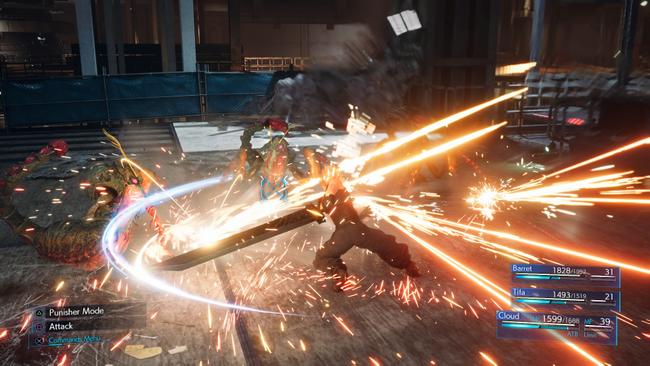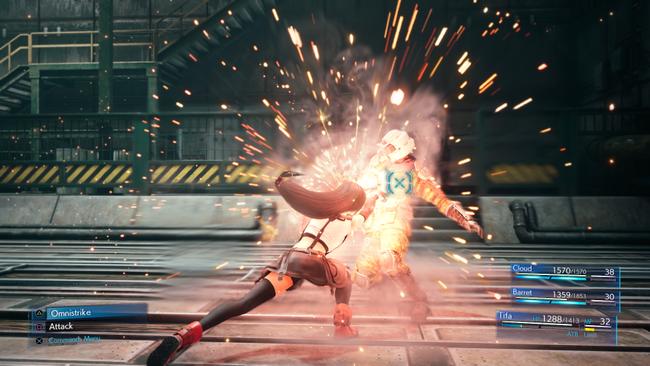Final Fantasy VII Remake hands-on: an excellent reimagining, though questions remain
It's hard to believe that Final Fantasy VII Remake is actually a real thing. It is tangible. You can pick up a controller and play it. There's a real, playable demo out now and in just a few weeks, everybody will be able to head into a store and buy it, revisiting at least a slice of the epic 1997 title anew. It's a miracle that this project has come to fruition - and even more surprising that it appears to be as good as it is.
I've played a little more than the demo, thanks to an invite from Square Enix to check out a preview build of the game. After playing over three hours of Final Fantasy VII Remake across various chapters of the full story, it's clear that the areas of the game Square Enix has chosen to show are nothing short of remarkable: it is visually beautiful, mechanically ambitious and smartly respectful to the original game. There is a vast amount of the game we still know nothing about, however - and at this late stage, it's unlikely that we will know until the process of writing a review begins.
The stuff we don't know about is that which had the most blank slate for the development team to play with; the all-new content that has little to no connection to the events that happened in Midgar in the original game. If you don't know, now is a good time to mention: the game out next month is called Final Fantasy VII Remake, but in real terms it is but a slice of the greater story, covering a portion of the sprawling PS1 epic that accounts for somewhere between a quarter and a third of the game's story.

But let's put the stuff we don't know about out of mind for a moment and focus on what we do know - what I could see and experience in the lengthy hands-on. The play session covered the opening chapter of the game (the Mako Reactor bombing), some of chapter 2 (the immediate aftermath of the bombing), chapter 7 (the second Mako Reactor bombing mission) and a boss from a later chapter still.
This was a good slice of the game in some senses and a frustrating slice in others: it let one experience the game's characters and combat at a few different levels of power and progression, but also limited play to the designated, fairly linear story missions that strictly shepherd you from one point to the next with scant deviation. What else is behind the curtain that might pad out the length of this Midgar chapter of the game to that of a full-length Final Fantasy isn't yet entirely clear.
That's not to say that these particular sections of the game haven't been significantly fattened up themselves, however. The initial reactor mission is roughly twice as long as it is in the original, the mission practically built around an epic, lengthy boss encounter and a frantic escape where the timer is twice as long as the original but so too is the distance you need to cover. While the bombing mission the original game spends only a few short minutes 'above the plate' surveying the aftermath of the attack, in the remake you'll spend the better part of an hour there, alternating between marvelling at the destruction and misery caused and getting into skirmishes with enemy soldiers on high alert.
The second Mako Reactor mission, when you're joined by Tifa, is probably an even better example of how these classic, but brief, set-pieces have been expanded for this release. In the original game, this mission is sort of a victory lap through areas you've seen before (albeit in a different location) and passes quite quickly until a surprise boss encounter. In the remake, the Air Buster boss is introduced earlier in the mission, hyped up as a robotic grim reaper that'll stomp you to dust. It’s now presented as a much more immediate, threatening force that Cloud and co. will have to deal with.
As you escape the reactor there's therefore a side mission where Cloud gathers up key cards and uses them at terminals to deny Air Buster ammunition or shut down some of its systems, which in turn make the inevitable boss encounter easier. There's some player choice here, too - which systems you deactivate will directly impact the way the boss tries to take you down later on. What was once running quickly through areas in five minutes becomes an extended search for keycards as you work your way to the exit.
The area design as you do this is linear and is reminiscent of Final Fantasy XIII - you'll wind through deserted stairways and corridors before arriving in a boxy room to fight some soldiers and spend your keycards multiple times - but sharp, clever combat and great character chatter and interaction help to hold it up. I didn't find it remotely boring, despite how it might very well sound on paper or how straightforward it looks on a map.
As previously noted, this sort of addition is good and smart, as are things like Sephiroth's first unsettling appearance to Cloud as a vision among the wreckage caused by the reactor explosion. At the very least, these moments offer you additional busy work and more excuses to get stuck into the remake's solid combat. At their best, these moments provide intriguing new twists or additional context to the story of the remake that will excite those familiar with Cloud's story and intrigue those who aren't. There's of course a third potential prong to this - at worst, some of these additions could muddy and destabilize a classic story. There was none of that in the sections I played, but the potential for additions to go awry is still palpable.
I keep mentioning the quality of the combat, so let's talk about that. It's excellent. In a sense these battles appear to have three direct ancestors: the Active Time Battles of the original Final Fantasy VII, the evolved meter-management driven ATB of Final Fantasy XIII and director Tetsuya Nomura's foray into real-time action in Kingdom Hearts. All three are represented here.
At the core of FF7 Remake is the classic ATB system as before. All major skills including unique character abilities, magic and even use of items are governed by an ATB gauge that gradually charges in battle - you can't do anything without expending one of these charges. But moment-to-moment, your basic sword (or fist, gun, or staff) attacks are handled in the manner of a real-time action game, with the Square button dishing out basic attacks and the Triangle button having some unique function for each of the four playable party members. There's dodging and blocking that can be done in the action layer, too.
One layer feeds the other, so attacking with basic attacks increases the ATB charge so that you can unleash more powerful attacks, buff or heal yourself every so often. This can actually lead to tense moments - you might desperately need a heal, but have no ATB charges available - but the quickest way to get a charge is to keep attacking. Aggressiveness is rewarded, but so are smart blocks.

These two sides of FF7 Remake's combat are also bridged and assisted by the Stagger system, smartly borrowed from FF13, which brings with it a similar tempo to battles as in that game. When an enemy is staggered they will take more damage, and enemies in the remake are generally hardier than in the original game. As such, the best way to take an enemy down is to first stagger them and then follow up with devastating heavy-hitting attacks. Some abilities are better for staggering, others are better for damaging. When an enemy is near stagger, there are hard choices to make about how to spend ATB charges: do you spend bars to get the stagger quicker, or hold them back to deal more damage afterwards? A bit of both? What if you desperately need a heal - do you press for the stagger rather than back off to regroup? It's good stuff, and most importantly keeps the player engaged in the moment to moment combat, especially in the spectacle of the numerous boss encounters..
What I wasn't able to get into in this build was the level and quality of RPG depth to long-term character progression. On the later saves available to us in our demo, the menus were laced with spoilers for surprises Square Enix preferred to keep for launch, so I didn't go looking within. But from the character progression visible outside of the menus, there's clearly a lot of growth for each character to do, and the open-ended ability for you to put any materia you like on any character remains - just now each character has more exclusive abilities themed to their specific skill set unlocked through other means.
Each character feels really unique as a result, though Cloud undeniably is the character the game's systems are built around. Tifa, Barret and Aerith are fun, but Cloud is the star. The game forcibly acknowledges this at the end of every battle, too - the perspective always switches back to Cloud once the last enemy is put away. You can't openly walk around as anybody else - they are effectively part of your combat toolset only. This is, after all, Cloud's story.
The execution of that story is excellent so far, by the way. There are a few iffy English voice reads, but the writing and translation is reverential to the source material while adding new layers and depth to each member of the cast. Within the confines of the existing elements of FF7, the slight tweaks and changes seem thus far to be carefully considered. The changes work, though there will no doubt be endless fan debate about many of these, such as if the story is enhanced by the new revelation that AVALANCHE isn't actually responsible for death and destruction, as ShinRa is self-destructing reactors as part of a ploy to use AVALANCHE to manipulate the public.
Within the confines of the areas shown in this preview, Final Fantasy VII Remake feels like everything one could've hoped for. They're doing it. It's good. And yet questions still remain. There's still so much of the game that is a mystery - all these new sections, new areas, and menus showing optional quests that might be at risk of becoming a slog of padding - fetch quests, hunts and so on. These elements of the game are still a question mark - though we're now only weeks from receiving answers to those same questions. I, of course, hope that the rest of the game lives up to these preview sections. For the moment, I’m very optimistic.